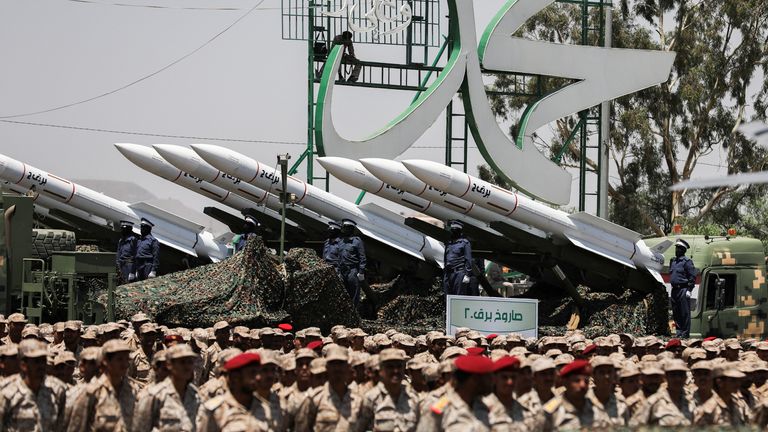- The Yemeni militia group have around 20,000 fighters and an arsenal which includes advanced drones, cruise and ballistic missiles, as well as anti-ship weapons
By Alex Rossi, International correspondent @alexrossiSKY
The attacks overnight on Houthi targets are a dramatic escalation of a crisis that is now in danger of boiling over across the Middle East.
They also reveal the failure of US and Western policy in the region – despite numerous warnings, Houthi attacks have continued in the Red Sea on commercial shipping, and they are likely to carry on after this military intervention.
US and British officials are keen to separate the link between the Houthis’ actions and what’s happening in Gaza – such statements are either disingenuous or misguided.
It is of course in Western interests for this narrative to be trotted out, but it doesn’t reflect the reality – as far as the Islamic world and much of the ‘Global South’ is concerned the US and the UK are both heavily embroiled in the Gaza war on the side of Israel and after last night’s events even more so.
The Houthis frequently make comparisons between the American-made bombs dropped by the Saudi-led coalition from American planes on them, and the same types of weaponry used on the Palestiniansin Gaza.
The Houthis are a Yemeni militia group named after their founder Hussein Badreddin al Houthi.
They are allied and backed by Iran and are part of the “axis of resistance” – baked into their DNA is a rejection of Israel “the Zionist entity” and its sponsor the United States.
Their official name is Ansarallah, and they have about 20,000 fighters.
Their image is that of a rag-tag army toting ageing Kalashnikovs, but that does not reflect what the group have become or their present-day military capabilities.
The Houthis – thanks to Iran – now have an arsenal which includes advanced drones, cruise and ballistic missiles, as well as anti-ship weapons.

The group controls the capital Sana’a as well as the strategically important Red Sea coastline.
Their leaders have stated their goal is to disrupt commercial shipping in the important waterway to force a ceasefire in Gaza and for the blockade of the Strip to be lifted.
The US-led attacks are unlikely to dent or deter their intent.
Although they were widespread, air power alone is unlikely to significantly degrade their capability.
For the last 10 years, the Houthis have faced similar barrages from the Saudi-led coalition and have not only survived but have become stronger.
It’s likely that these strikes by the US-led coalition will not be the last.
@Sky News

